
Microwave experiments at school
Halina Stanley introduces a number of spectacular classroom experiments using…

Explore the everyday science behind the quest to harness fusion energy – the energy that powers the stars – in a safe way here on Earth.
The quest for fusion energy, a potentially sustainable and plentiful power source, has been a challenging journey because of the intricate technology needed to tap into the energy of stars. However, some of the basic concepts of fusion are analogous to familiar things we see in our homes, on the streets, and in nature.
Fusion energy is a form of power that is generated by merging atoms together. This is the same process that powers the sun and other stars.
Scientists around the world have been working to develop a way to harness this energy on Earth. One of the most promising methods for achieving this is through the use of a device called a ‘tokamak’.
A tokamak is a machine in which a small amount of hydrogen gas is heated to a very high temperature at which the electrons detach from the atoms. This mixture of charged particles is called a ‘plasma’. The plasma is made up of hydrogen nuclei, some of which fuse together to form helium and release a large amount of energy in the process. The goal of the tokamak is to create conditions for this fusion reaction to take place in a sustained manner and generate a significant amount of energy that may be used to power homes and cities in the future.
Tokamak, pronounced toe-ka-mak, is a term that might sound like it is straight out of a science-fiction novel, but it is actually a real-world technology that scientists are using to unlock the power of the stars and create a new source of energy here on Earth. A tokamak is torus-shaped, which means it is circular with a hole in the middle. In other words, it is a huge donut-shaped device!
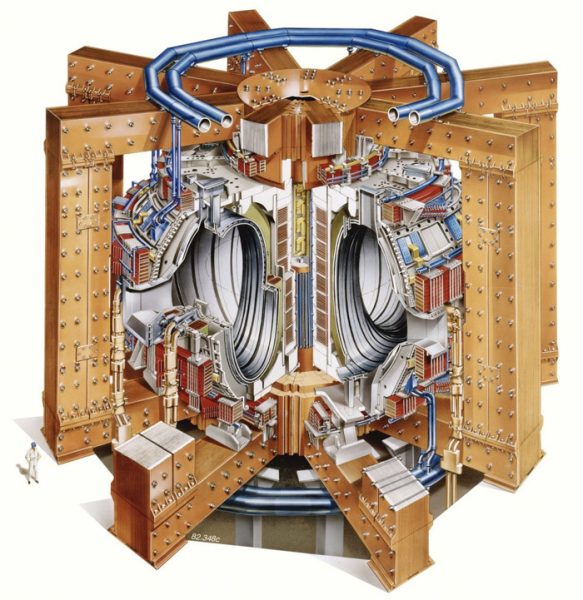
One of the most well-known tokamak machines is the Joint European Torus (JET) located in Culham, UK, and used exclusively for EUROfusion research. JET is the largest tokamak in the world and has been instrumental in advancing our understanding of fusion energy. Of all the tokamaks currently in operation, only the JET tokamak can use both deuterium (2H) and tritium (3H) as fuel. This is the planned fuel for almost all future first-generation fusion power plant designs. Deuterium is available in huge quantities in sea water, whereas tritium can be created from the abundant metal lithium. With deuterium and tritium, EUROfusion researchers achieved the highest fusion energy and fusion power ever produced by a tokamak at JET.
An isotope is like a secret agent among atoms. Atoms are made up of protons, neutrons, and electrons. Isotopes are atoms of the same element (e.g., hydrogen, carbon) but with a different number of neutrons. Isotopes of the same element have the same number of protons, which gives them the same chemical properties, but a different number of neutrons, which gives them different physical properties.
The tokamak is a complex machine, but many of the technologies used in it can be found in everyday science. For example, the plasma in the tokamak is similar to the lightning seen during a thunderstorm or the hot gas in a fluorescent tube.

Plasmas are made up of negatively charged electrons and positively charged nuclei. These charged particles can be held inside a tokamak’s vacuum chamber without touching the walls, thanks to powerful magnetic fields. Inside the tokamak, the plasma particles are heated to extremely high temperatures of up to 150 million degrees Celsius. This is much hotter than the Sun’s core, which is estimated to be around 15 million degrees Celsius.
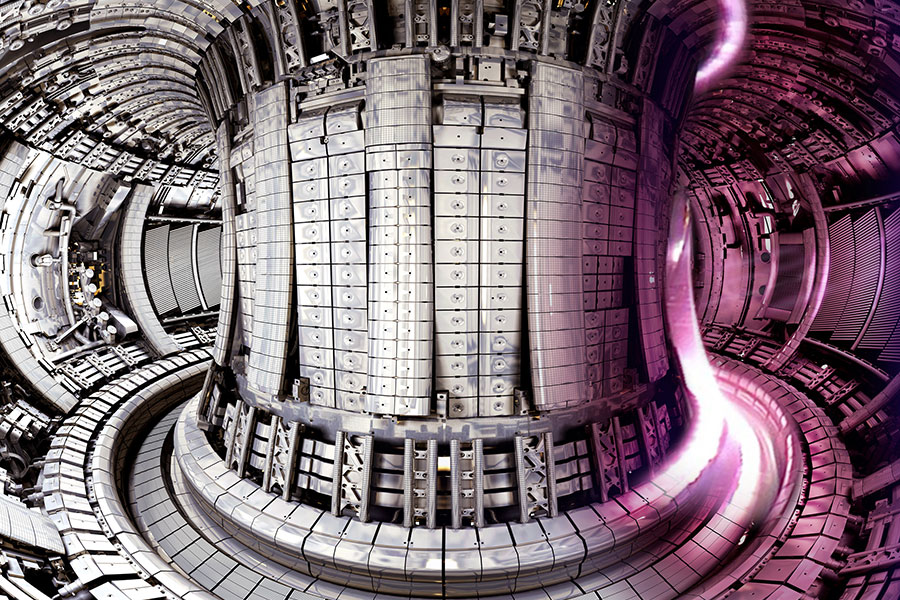
The magnetic confinement system in the tokamak is similar to the principles used in an electric motor. An electric motor uses a magnetic field to create movement and the tokamak uses a similar concept to keep the plasma in the right place. The magnets create a strong magnetic field that surrounds the plasma, trapping it in the centre of the tokamak. Future tokamaks will use superconducting magnets, which are made of special materials that can conduct electricity without losing any energy.
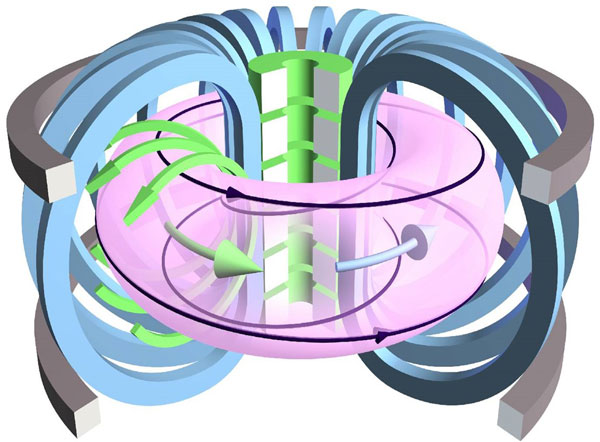
Once the plasma is captured in a magnetic cage, it’s time to start heating it. One way to do this is by using microwaves similar to those used in your kitchen microwave oven. However, the microwaves in the tokamak are at a much higher frequency and power than those found in your kitchen microwave. Both use electromagnetic waves like radio waves but with a higher frequency/shorter wavelength. One property of these waves is the ability to make particles move, which heats the plasma by making the particles move faster and collide together with more force, which makes the fusion reaction more likely to happen. This is similar to heating food in a kitchen microwave.
One of the biggest challenges in developing fusion energy is achieving a sustained fusion reaction. Scientists need to make sure that the plasma is hot enough and the magnetic field is strong enough to keep the plasma confined in the tokamak for long enough to generate a significant amount of energy. EUROfusion researchers at JET have made significant progress in this area, and have achieved sustained fusion reactions for several seconds at a time. Future tokamaks, like the International Thermonuclear Experimental Reactor (ITER) device, are designed to create high-energy plasmas for fifteen to sixty minutes at a time.
JET, the Joint European Torus, is an old but powerful machine that has been a key player in advancing our understanding of fusion energy. But, like all technology, it’s not perfect. JET uses magnets that are not superconducting, which means they heat up quickly, and with high-energy plasmas the magnets can only run for around five seconds. But don’t worry, scientists have been working on new and improved versions of the tokamak and they’ve come up with a game-changer: superconducting magnets. These special magnets can conduct electricity without losing any energy and, importantly, without heating up. This means that future tokamaks with superconducting magnets will not face the same limitations as JET and will be able to run for longer periods of time, bringing us a step closer to making fusion energy a reality.
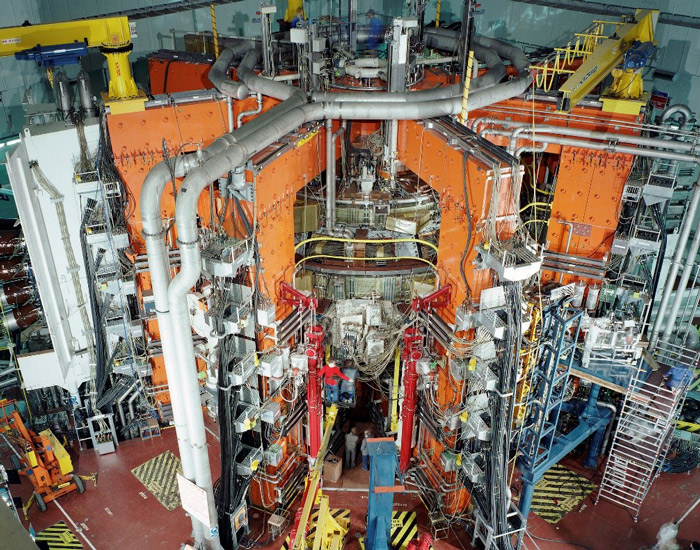
Another important aspect of the tokamak is the cooling system. A tokamak like JET generates a large amount of heat, which needs to be removed to prevent damage to the machine. The JET tokamak primarily uses inertial cooling but it also has a limited water-cooling system to remove the heat from its divertor, which is similar to the cooling systems used in power plants today.
In the future, the aim is that fusion power plants will use the heat produced by fusion reactions to run steam turbines and generate electricity. They will transform the process that powers the stars into a way for us to generate clean electricity here on Earth.
The tokamak is a complex machine that uses a combination of technologies to confine and heat plasma and create conditions for fusion reactions to take place. Many of the technologies used in the JET tokamak can be related to everyday science, such as plasma seen as lightning in thunderstorms, the principles behind electric motors, and the microwaves in kitchen microwave ovens. The challenge is to develop and optimize all these technologies and bring them together create a stable system, a task that requires extensive collaboration between engineers and scientists from a broad range of fields. Although the goal of sustained fusion reactions and a practical source of energy is still a work in progress, EUROfusion research into tokamaks like JET are bringing us closer to making fusion energy a reality.
Some comprehension questions that can be used after the class:

Halina Stanley introduces a number of spectacular classroom experiments using…

Helium: gas of awe, wonder, and worry. Is it time to give this noble gas the respect it…
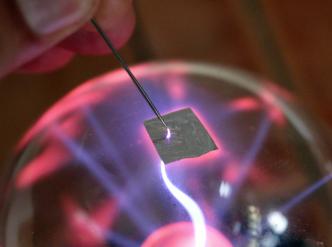
Plasma is the fourth state of matter, after solid, liquid and gas – but what is it like and what can it do? Plasma globes allow us to answer these…